Hyloxalus abditaurantius is a species of frog in the family Dendrobatidae. It is endemic to Colombia.
Hyloxalus fascianigrus is a species of frogs in the family Dendrobatidae. It is endemic to Colombia.

Colostethus pratti is a species of frog in the family Dendrobatidae. It is found in the northwestern Colombia and Panama, possibly also in southeastern Costa Rica. It is sometimes known as the Pratt's rocket frog. Colostethus pratti is named after Antwerp Edgar Pratt, an explorer who collected the type series.
Hyloxalus vertebralis is a species of frog in the family Dendrobatidae. It is endemic to southern Ecuador and occurs in the inter-Andean valleys and on the western slopes of the Andes.
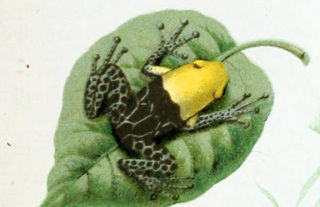
The red-headed poison frog, fantastic poison frog, or crowned poison frog is a species of frog in the family Dendrobatidae. It is endemic to Peru and found in the northern San Martín and Loreto Regions.

The Andean poison frog is a species of frog in the family Dendrobatidae. It is endemic to Colombia.
Ameerega braccata, formerly Epipedobates braccatus, is a species of frog in the family Dendrobatidae. It is endemic to the Central-West Region of Brazil and is known from southern Mato Grosso, Mato Grosso do Sul, and southwestern Goiás states; however, it is likely that its true range extends into adjacent Bolivia and Paraguay.
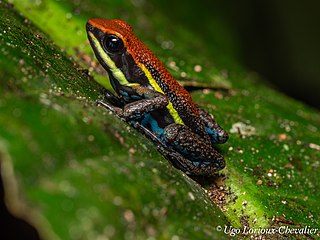
The Cainarachi poison frog is a species of frogs in the family Dendrobatidae. It is endemic to Amazonian Peru and found in the lowlands adjacent to the northern end of the Eastern Andes. It was named after the Rio Cainarache Valley, where it was first discovered.
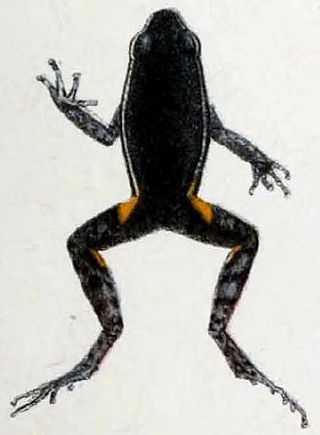
Ameerega hahneli is a species of frog in the family Dendrobatidae. It is found in the Amazonian lowlands of Brazil, Bolivia, Peru, Ecuador, Colombia, Venezuela, Guyana, French Guiana, and Suriname. It is named after Paul Hahnel, the collector of the type series.
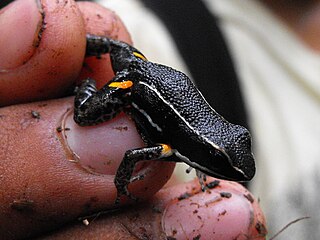
The spot-legged poison frog is a species of dendrobatid frog found in Bolivia, Brazil, Peru, and Venezuela.

Ameerega pulchripecta, formerly Epipedobates pulchripecta, is a species of frog in the family Dendrobatidae endemic to Brazil.
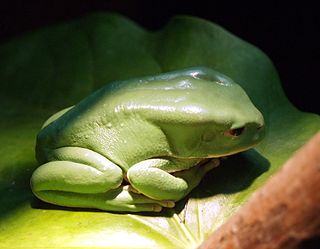
Phyllomedusa boliviana is a species of frog in the subfamily Phyllomedusinae. It is found in Argentina, Bolivia, and Brazil. It has been observed between 200 and 1800 meters above sea level.

Phyllomedusa tarsius, the brownbelly leaf frog or tarsier leaf frog, is a species of frog in the subfamily Phyllomedusinae. It is found in Brazil, Colombia, Ecuador, Peru, and Venezuela, and possibly Bolivia and Guyana. This frog has been observed as high as 800 meters above sea level.

Craugastor raniformis is a species of frog in the family Craugastoridae. It is found in Colombia and Panama. It is a reasonably common species found in humid lowland and montane forests up to 1,500 m (4,900 ft) asl. It is also common in wet pastureland. Furthermore, it is one of the dominant frogs in abandoned mixed farming areas in the coastal Pacific rainforests in Colombia. This adaptable species is not considered threatened.

Platymantis guentheri is a species of frog in the family Ceratobatrachidae. It is endemic to the Philippines, where it occurs in the rainforests of Leyte, Biliran, Maripipi, Bohol, Panglao, Dinagat, and Mindanao islands. Its natural habitats are subtropical or tropical moist lowland forest, subtropical or tropical moist montane forest, plantations, rural gardens, and heavily degraded former forest. It has been observed as high as 700 meters above sea level.

Chirixalus doriae, commonly known as Doria's Asian treefrog, Doria's bush frog, and Doria's tree frog, is a species of frog in the family Rhacophoridae. It is found in southeastern Asia, from extreme northeastern India and adjacent Bangladesh to Myanmar, Thailand, Cambodia, Laos, Vietnam, and southern China.
Philautus cornutus is a species of frog in the family Rhacophoridae. It is endemic to Indonesia. It has been observed 1529 and 1907 meters above sea level.

Raorchestes travancoricus, variously known as the Travancore bushfrog, Travancore bubble-nest frog, or Travancore tree frog, is a species of frog in the family Rhacophoridae. The species is endemic to the southern Western Ghats, India. Its specific name, travancoricus, as well as its three common names, refer to its type locality, Bodinayakkanur in the former Travancore state.

Ameerega shihuemoy, the Amarakaeri poison frog, is a species of dart frog endemic to a small region in southeastern Peru in the Manú District where it lives in the transition zone between montane rainforest and the lowland rainforest. The frog is a member of the Ameerega picta group. It was discovered at the Manú Learning Centre where it is known to occur in pieces of selectively logged forest. This species is threatened by habitat loss due to agriculture, gold mining, oil extraction, road construction, and logging. Currently the frog is only known from nine locations globally; three sites in the Manú Biosphere Reserve, and six in Amarakaeri Communal Reserve. Initially it was considered for a status of vulnerable or near-threatened, but due to its low number of known localities it has been considered endangered.

Ameerega parvula is a species of poison dart frog that lives in Colombia, Ecuador and Peru.















